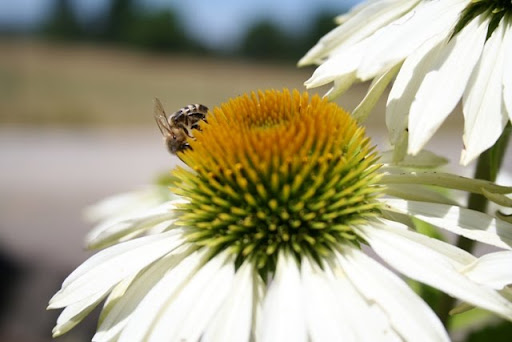Tuesday, July 28, 2009
Healing and the Soil
Wisdom is often found in the uncomfortable. Picris echioides L., known as Bristly Oxtongue or more fondly by a friend as Velcro Plant, was the day's assignment for me in a garden. The intent was to prevent proliferation of the already plentiful plant by cutting its stems and flowers prior to its seeds being dispersed by the wind. As I cut each, Felco pruners in hand, the common names for these plants found expression on my garden gloves, bristles spearing through the glove's thick mesh. Tolerable. The occasional plant merited a tug and as I pulled out the strong tap root, the dialogue within me transformed. In our rich clay soils that can result in broken shovels, these tap roots become a path over which water, insects and microbes can travel into the soils. FeralKevin has found it beneficial when planting among the Picris, as the roots of a more delicate plant can follow this fearsome tap root down into the soil on a quest for moisture and nourishment. On this particular day, I was thankful that I had not time to dig each plant out; in fact, my small shovel had broken in the clay after just two attempts. As I gathered the cuttings, I reflected upon the similarity of Picris and Comfrey, the marvelous healing plant with high biomass, whose name is from the Latin word conferta, meaning "to grow together". Shall we then keep the Picris within the garden and attend to it with a simple pruning? Coexistence? I think so. Conferta? With open minds and resilient choices, we shall.
Monday, July 20, 2009
Heroes, Microbes and Earth
My interest in the Microbiology of Soil is rooted in the fact that the health of our plants begins and ends the level of microbial diversity in the soil. It is this that creates the essence of the soil food web. You can glance at this page and it illustrates beautifully the topic. http://soils.usda.gov/sqi/concepts/soil_biology/soil_food_web.html My fascination with this information allows you to understand why Soil Geek is an appropriate title for me.
One of my heroes is a microbiologist, Dr Elaine Ingham. She now heads a firm, Soil Food Web Inc. http://www.soilfoodweb.com/03_about_us/approach.html My work with her has transformed my vision of how we can work with soil and nurture plants. Another hero, Dr Carole Ann Rollins, brews the Actively Aerated Compost Tea ("AACT") that I apply to my own and clients' gardens. http://www.nature-technologies.com/
Organisms live in the microscale environments within and between soil particles. Differences over short distances in pH, moisture, pore size, and the types of food available create a broad range of habitats. Therefore, dirt doesn’t turn to soil overnight nor does compaction transform in a short time. However, if we nurture the opportunity for microbiology to regain its natural state in a situation where dirt and compaction exist, we can create the opportunity for the soil food web to become engaged and, thereby, soil is made. We just provide the conditions for the abundance.
One of my heroes is a microbiologist, Dr Elaine Ingham. She now heads a firm, Soil Food Web Inc. http://www.soilfoodweb.com/03_about_us/approach.html My work with her has transformed my vision of how we can work with soil and nurture plants. Another hero, Dr Carole Ann Rollins, brews the Actively Aerated Compost Tea ("AACT") that I apply to my own and clients' gardens. http://www.nature-technologies.com/
Organisms live in the microscale environments within and between soil particles. Differences over short distances in pH, moisture, pore size, and the types of food available create a broad range of habitats. Therefore, dirt doesn’t turn to soil overnight nor does compaction transform in a short time. However, if we nurture the opportunity for microbiology to regain its natural state in a situation where dirt and compaction exist, we can create the opportunity for the soil food web to become engaged and, thereby, soil is made. We just provide the conditions for the abundance.
Our response to conflict impacts the outcome. Our response to change impacts its effect. Ethos Landscape implements the principles of Permaculture with recognition of the socio-economic and environmental impacts these decisions imply.
We are about nurturing—plants, soil, creatures, individuals, communities. No chemicals, no synthetic fertilizers, no toxins. We plan lush gardens that are drought tolerant. We incorporate natives as often as possible. Simply, we seek to design, install and maintain beautiful and functional landscapes that enhance work, rest, learning and play while honoring the ecosystems within which we all live.
- Jae Koenig
We are about nurturing—plants, soil, creatures, individuals, communities. No chemicals, no synthetic fertilizers, no toxins. We plan lush gardens that are drought tolerant. We incorporate natives as often as possible. Simply, we seek to design, install and maintain beautiful and functional landscapes that enhance work, rest, learning and play while honoring the ecosystems within which we all live.
- Jae Koenig
Subscribe to:
Posts (Atom)
